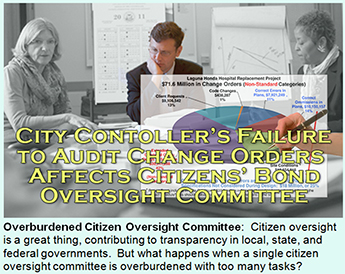 Article in Print Printer-friendly PDF file
Article in Print Printer-friendly PDF fileWestside Observer Newspaper
July 2017 at www.WestsideObserver.com
“Oversight Committee” Provides Scant oversight
Part 1:
Failure to Monitor Change Orders
 Article in Print Printer-friendly PDF file
Article in Print Printer-friendly PDF file
Westside Observer
Newspaper
July 2017 at www.WestsideObserver.com
“Oversight Committee” Provides Scant oversight
Part 1:
Failure to Monitor Change Orders
by Patrick Monette-Shaw
San Francisco’s Citizens’ General Obligation Bond Oversight Committee (CGOBOC) not only has a performance problem, it has an image problem. Most San Franciscans have no clue of what this Committee does or is supposed to do, despite the fact it was 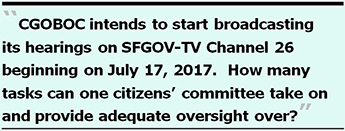 created by a vote of the citizens at the ballot box.
created by a vote of the citizens at the ballot box.
Only a handful of citizens currently attend CGOBOC’s bi-monthly meetings, derisively referred to as the “usual suspects.” That may be about to change, because CGOBOC intends to start broadcasting its hearings on SFGOV-TV Channel 26 beginning on July 17, 2017 after being prodded by this author and other open government advocates to do so — over the initial opposition of CGOBOC’s current chairperson, Brian Larkin, and other initially-hesitant CGOBOC members.
CGOBOC: Overburdened, Understaffed
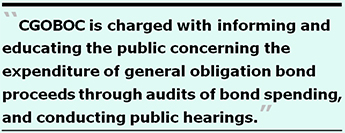 Oversight and transparency look great on paper, but just how many tasks can one citizens’ committee take on and provide adequate oversight over?
Oversight and transparency look great on paper, but just how many tasks can one citizens’ committee take on and provide adequate oversight over?
Bond Oversight Tasks
On March 5, 2002 voters passed Proposition “F,” the Citizen Oversight of Bond Expenditures Initiative. Prop. “F” established CGOBOC as a committee of nine members to oversee all general obligation bonds passed by voters. The Committee is charged with actively reviewing and regularly reporting on the expenditure of taxpayers’ money in accordance with the specifically-stated uses of each bond measure. They are charged with ensuring bond revenues are spent in accordance with the bond measure and ensuring that no funds are used for administrative salaries or general government operating expenses.And the Committee is charged with informing and educating the public concerning the expenditure of general obligation bond proceeds through audits of bond spending, and conducting public hearings. Each bond must set aside one-tenth of one percent (0.1%) of the bond amount passed by voters to support the Committee’s audit and oversight functions. The Committee is authorized to commission independent review of bond expenditures and are also authorized to hire outside auditors, inspectors, and other experts to conduct the independent review.
For most of its now 15-year history overseeing bond spending, CGOBOC has relied mostly on the City Controller’s Office, which provides administrative support to the Committee. Only in 2015 did CGOBOC finally use an “external auditor” independent of the Committee and the City Controller’s Office to conduct external audits of three bond programs. CGOBOC has not requested, or engaged, outside auditors to audit any other general obligation bonds in 2016, or to date in 2017.
Committee members are largely not required to have subject-matter experience. Three members are appointed by the Mayor, one each from a community organization, a labor organization, and a business organization representing the City’s business community. Three members are appointed by the Board of Supervisors from the same three types of organizations. One member is appointed by the Civil Grand Jury, with no stipulated requirements.
Only the two members appointed by the City Controller appear to require subject-matter expertise: One member with expertise in auditing government financial statements or experience in public finance, and one member with experience in construction management.
 Each member serves a two-year term and may be re-appointed to a second two-year term. One obvious problem with the term limits is that many of the bond programs are spread over six, to eight, to ten years, such that by the time a member completes their two-year or four-year terms, there is turnover on the Committee with a concomitant loss of historical knowledge and institutional memory of what may have transpired earlier in the life of a given bond. That creates an additional burden on the Committee to have to research bond presentations to CGOBOC and discussion of previous CGOBOC findings made prior to the start of their term, in the middle or late years of a given bond.
Each member serves a two-year term and may be re-appointed to a second two-year term. One obvious problem with the term limits is that many of the bond programs are spread over six, to eight, to ten years, such that by the time a member completes their two-year or four-year terms, there is turnover on the Committee with a concomitant loss of historical knowledge and institutional memory of what may have transpired earlier in the life of a given bond. That creates an additional burden on the Committee to have to research bond presentations to CGOBOC and discussion of previous CGOBOC findings made prior to the start of their term, in the middle or late years of a given bond.
When CGOBOC was formed to provide oversight of bond spending, the City had a handful of (or perhaps just one) active general obligation bonds to monitor. Today CGOBOC is charged with oversight of almost a dozen bond measures totaling $3.6 billion in bond funding, for which CGOBOC has been awarded $3.6 million to oversee:
Table 1: San Francisco General Obligation Bonds (GOB) Approved by Voters 2000 – 2016
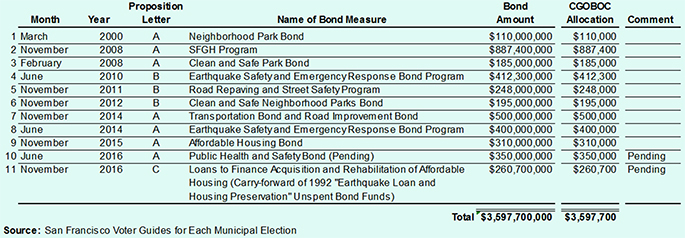
Even City Controller Ben Rosenfield noted to CGOBOC members during its May 25, 2017 meeting while considering CGOBOC’s “work plan” for the upcoming fiscal year set to start on July 1:
“So at the time the Committee was formed, you [only] had a couple of bonds. Today you have approaching a dozen bonds that have been authorized by the voters. So the scope of what you are responsible to oversee has grown. The Committee has responded to that by kind of designating liaisons that are responsible then for … more detailed review [of individual documents about] bond programs.”
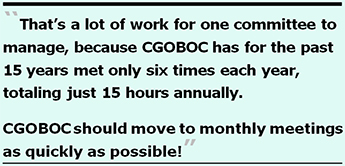 In and of itself, that’s a lot of work for one committee to manage, in part because CGOBOC has for the past 15 years met only six times annually, every other month. Given City Hall meeting room constraints, CGOBCO’s meetings typically last only two-and-a-half hours, from 9:30 a.m. to noon when they must vacate their hearing room. That means CGOBOC meets for just 15 hours annually. CGOBOC should move to monthly meetings, quickly.
In and of itself, that’s a lot of work for one committee to manage, in part because CGOBOC has for the past 15 years met only six times annually, every other month. Given City Hall meeting room constraints, CGOBCO’s meetings typically last only two-and-a-half hours, from 9:30 a.m. to noon when they must vacate their hearing room. That means CGOBOC meets for just 15 hours annually. CGOBOC should move to monthly meetings, quickly.
Rather than meeting every month, or forming standing subcommittee meetings to handle it’s GOB oversight duties and workload, CGOBOC has creatively turned to assigning liaisons from the Committee to each bond program manager to examine in greater detail issues around given bond measures than is presented in the quarterly reports from program managers. By report, the liaisons are expected to uniformly request, obtain, and read extended documents beyond the quarterly reports. Whether the liaisons uniformly do so is not known, nor is it known whether the liaisons report back to the full Committee on what they may have learned reading documents in addition to the quarterly reports. Admittedly, liaisons do perform duties outside of regularly-scheduled full CGOBOC meetings.
By way of contrast, applicants to serve on the Civil Grand Jury are advised on the application form that they should be willing to commit to devoting a minimum of five to ten hours weekly, or approximately 500 hours annually. The Grand Jury typically meets weekly from 4:00 p.m. to 7:00 p.m. at City Hall, for a total of approximately 156 hours annually just for Grand Jury meetings alone.
Shoveling on Additional Oversight Tasks: CARB
As if the 11 current bonds weren’t enough work to effectively monitor, just 17 months after CGOBOC was created in March 2002 the Board of Supervisors voted on July 15, 2003 to place Proposition “C” on the November 2003 ballot to create the City Services Auditor (CSA) function within the Controller’s Office, piling additional oversight responsibilities onto CGOBOC members, rather than creating a separate citizens’ committee to take on an entirely different type of oversight responsibilities.
 Prop. “C” requires the City to set aside two-tenths of one percent (0.2%) annually of the entire City budget to support the Controller’s CSA unit. For example, the City budget of $10 billion for the fiscal year to begin on July 1, 2017 requires that the City set aside fully $20 million dollars for the CSA function. What will the CSA spend that $20 million on?
Prop. “C” requires the City to set aside two-tenths of one percent (0.2%) annually of the entire City budget to support the Controller’s CSA unit. For example, the City budget of $10 billion for the fiscal year to begin on July 1, 2017 requires that the City set aside fully $20 million dollars for the CSA function. What will the CSA spend that $20 million on?
After nearly two decades of observing the various antics at City Hall, I hate to sound naïve — or worse, jaded — wondering whether the piling on of additional duties was done intentionally to distract CGOBOC from its core responsibilities to provide meaningful and adequate oversight of bond spending.
 Voters passed Prop. “C” on November 4, 2003 adding to the duties of CGBOC, requiring that CGOBOC also serve as a Citizens Audit Review Board (CARB), and as the CARB also: 1) Review the Controller’s service standards and benchmarks to ensure their accuracy and usefulness; 2) Review all CSA audits; 3) Review complaints received through the City Controller’s Whistleblower Hotline and disposition of the complaints; and 4) When appropriate, hold public hearings regarding the results of benchmark studies and audits.
Voters passed Prop. “C” on November 4, 2003 adding to the duties of CGBOC, requiring that CGOBOC also serve as a Citizens Audit Review Board (CARB), and as the CARB also: 1) Review the Controller’s service standards and benchmarks to ensure their accuracy and usefulness; 2) Review all CSA audits; 3) Review complaints received through the City Controller’s Whistleblower Hotline and disposition of the complaints; and 4) When appropriate, hold public hearings regarding the results of benchmark studies and audits.
The CSA cranks out lots of various kinds of audits. Reviewing all audits is another full-time job tacked on to the full-time duties CGOBOC already had providing bond oversight! What could possibly go wrong?
Understaffed and Overburdened
In addition to being overburdened with too many duties and tasks, CGOBOC has faced an understaffing problem.
A review of CGOBOC’s 12 meeting agendas over the two-year period between July 30, 2015 and June 14, 2017, fully 25% (3 agendas) listed only six CGOBOC members (rather than its nine-member full complement), 8.3% (1 agenda) listed seven members, 41.7% (5 agendas) listed eight members, and only 25% (3 agendas) listed a full complement of nine members. That includes all members currently assigned to CGOBOC, but doesn’t account for members who may have been absent or excused from any of those 12 meetings.
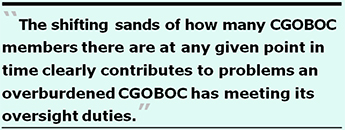 The Controller’s Office confirmed that one seat on CGOBOC appointed by the Mayor as active in a community organization has been vacant for fully 13 months. Either the Mayor can’t find someone from a community organization interested in serving on CGOBOC, or the Mayor is too busy to bother looking around to find someone to appoint.
The Controller’s Office confirmed that one seat on CGOBOC appointed by the Mayor as active in a community organization has been vacant for fully 13 months. Either the Mayor can’t find someone from a community organization interested in serving on CGOBOC, or the Mayor is too busy to bother looking around to find someone to appoint.
The shifting sands of how many CGOBOC members there are at any given point in time clearly contributes to problems an overburdened CGOBOC has meeting its oversight duties, placing more work on fewer Committee members.
And it bears repeating that CGOBOC has — since its inception 15 years ago — chosen to only meet every other month, and not form subcommittees to manage its overburdened oversight workload.
The City’s “3% Solution” Change Order Quagmire
In early 2010, when I landed as a City employee in the Capital Division of the Recreation and Parks Department, I soon and happily stumbled across, as part of my job, news that the Department of Public Works had a robust system to report change orders on the Laguna Honda Hospital replacement project, and all other bond-funded projects.Over the years, I have written extensively in the Westside Observer about various problems involving change orders, including “LHH Lessons Unlearned Impacts All Bond-Financed Projects” (May 2010) following the disastrous LHH “design-build” project that started 13 years ago that involved a staggering $71.6 million in change orders; “Housing Delays = Justice Denied” (November 2016); and “Affordable Housing Bond Lurches Down a Cliff” (March 2017).
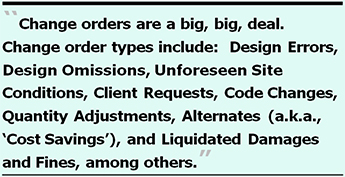 Change orders are a big, big, deal. Change order types include: 1A) Design Errors necessary to resolve and correct errors made during design; 1B) Design Omissions necessary to resolve and correct omissions due to a lack of information that should have been considered during design; 2) Unforeseen Site Conditions encountered during construction; 3) Client Requests, including client- or owner-initiated requests to add, change, or delete scope to the project after design was completed; 4) Code Changes to comply with construction codes revised after completion of design and the issued permits; 5) Quantity Adjustments to incorporate savings from actual quantities installed during construction; 6) Alternates (a.k.a., the “Cost Savings” category) to incorporate cost savings, and/or additional work submitted as alternates during the bid, and later awarded as contract modifications; 7) Liquidated Damages and Fines (ostensibly against contractors or sub-contractors); 8) Errors: Purportedly not used, but included in the Neighborhood Parks bonds, as perhaps other “Errors” during construction above and beyond Design Errors; and 9) CM/GC: CM/GC (“Construction Manager/General Contractor” ) are change orders in a bid process to be expected, as the design was not yet completed when the budget for the trade package was set.
Change orders are a big, big, deal. Change order types include: 1A) Design Errors necessary to resolve and correct errors made during design; 1B) Design Omissions necessary to resolve and correct omissions due to a lack of information that should have been considered during design; 2) Unforeseen Site Conditions encountered during construction; 3) Client Requests, including client- or owner-initiated requests to add, change, or delete scope to the project after design was completed; 4) Code Changes to comply with construction codes revised after completion of design and the issued permits; 5) Quantity Adjustments to incorporate savings from actual quantities installed during construction; 6) Alternates (a.k.a., the “Cost Savings” category) to incorporate cost savings, and/or additional work submitted as alternates during the bid, and later awarded as contract modifications; 7) Liquidated Damages and Fines (ostensibly against contractors or sub-contractors); 8) Errors: Purportedly not used, but included in the Neighborhood Parks bonds, as perhaps other “Errors” during construction above and beyond Design Errors; and 9) CM/GC: CM/GC (“Construction Manager/General Contractor” ) are change orders in a bid process to be expected, as the design was not yet completed when the budget for the trade package was set.
There’s another weird category, called “Base Scope Buy-Out,” that perhaps has only been used to date as a change order type on the SFGH rebuild bond program, discussed in more detail below.
 Of note, both DPW and individual project construction managers have employees known as “plan checkers.” A reasonable person would have to conclude that the plan checkers should detect Design Errors, Design Omissions, and “Code Interpretations” during approval of project plans, particularly since both architects and plan checkers should know of, and keep abreast of, various building and regulatory “code changes” to maintain their professional licensure.
Of note, both DPW and individual project construction managers have employees known as “plan checkers.” A reasonable person would have to conclude that the plan checkers should detect Design Errors, Design Omissions, and “Code Interpretations” during approval of project plans, particularly since both architects and plan checkers should know of, and keep abreast of, various building and regulatory “code changes” to maintain their professional licensure.
When I wrote each of those articles noted above, I had no idea that the Department of Public Works (DPW) may have an internal goal of holding change orders involving design errors and design omissions to just 3% of project costs. It doesn’t seem that the 3% “solution” ever occurred for errors and omissions!
Take for instance the significant change orders in the Recreation and Parks Department’s 2008 and 2012 Neighborhood Parks bond measures.
Table 2: Change Orders in Two Separate Neighborhood Parks Bonds1, 2

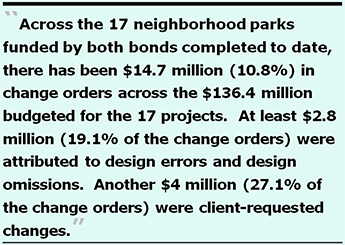 As Table 2 above shows, across all of the 12 neighborhood parks funded by the 2008 Neighborhood Parks Bond, at least 20.1% of the $12.3 million in change orders to date were attributed to design errors and design omissions. And across the five neighborhood parks funded by the 2012 Neighborhood Parks Bond for which data is available, at least 13.6% of the $2.4 million in change orders to date were attributed to design errors and design omissions. There’s still 10 projects remaining on the 2012 Parks bond, likely with further change orders.
As Table 2 above shows, across all of the 12 neighborhood parks funded by the 2008 Neighborhood Parks Bond, at least 20.1% of the $12.3 million in change orders to date were attributed to design errors and design omissions. And across the five neighborhood parks funded by the 2012 Neighborhood Parks Bond for which data is available, at least 13.6% of the $2.4 million in change orders to date were attributed to design errors and design omissions. There’s still 10 projects remaining on the 2012 Parks bond, likely with further change orders.
Across the 17 neighborhood parks funded by both bonds completed to date, there has been $14.7 million (10.8%) in change orders across the $136.4 million budgeted for the 17 projects. At least $2.8 million (19.1% of the change orders) were attributed to design errors and design omissions. Another $4 million (27.1% of the change orders) were client-requested changes. The $14.7 million in total change orders could have improved two, three, or more additional neighborhood parks and playgrounds.
To my knowledge, CGOBOC has not examined in-depth the $14.7 million in total park bond change orders.
2008 Neighborhood Parks Bond Change Orders
As Table 3 below illustrates, across the 12 projects in the 2008 Neighborhood Parks bond there were a whopping 107 change orders that between them had a staggering 1,529 rows (lines) describing in some abbreviated detail the various change orders involved. That averages out to 8.9 change orders per project, and 127.4 line-items per project. Figure 1 provides a visual of data presented in Table 4.
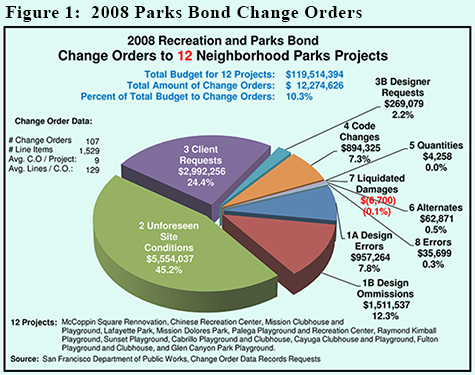 Table 3: Number of Change Orders on 2008 Parks Bond
Table 3: Number of Change Orders on 2008 Parks Bond
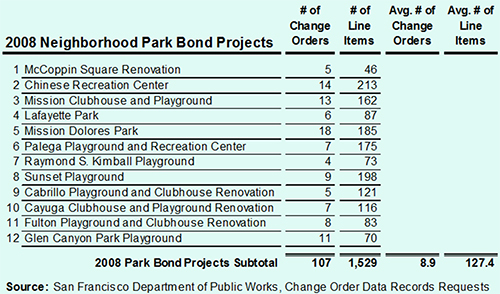
Table 4: Detailed Change Order Data for Each Project in the 2008 Parks Bond

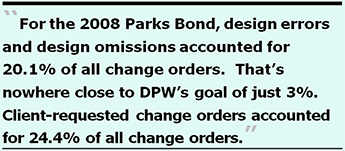 As Table 4 shows, there was significant variability across the 12 parks projects in the various types of change orders, ranging from just 3.26% of change orders as a percent of a project’s budget, to 19.3% on the Mission Dolores Park renovation.
As Table 4 shows, there was significant variability across the 12 parks projects in the various types of change orders, ranging from just 3.26% of change orders as a percent of a project’s budget, to 19.3% on the Mission Dolores Park renovation.
Again, as Table 2 above shows, for the 2008 Parks Bond design errors and design omissions accounted for 20.1% of all change orders. That’s nowhere close to DPW’s goal of 3%! Client-requested change orders accounted for 24.4% of all change orders.
Overall, the 12 projects totaled $12.3 million in change orders compared to the initial $119.5 million total budget, averaging 10.3% in change orders per project.
2012 Neighborhood Parks Bond Change Orders
As Table 5 below illustrates, across the 5 projects started or completed in the 2012 Neighborhood Parks bond to date, there have been 25 change orders with 194 rows (lines) describing in abbreviated detail various change orders involved. That averages out to five change orders per project, and 38.8.line-items per project. Figure 2 provides a visual of data presented in Table 6.
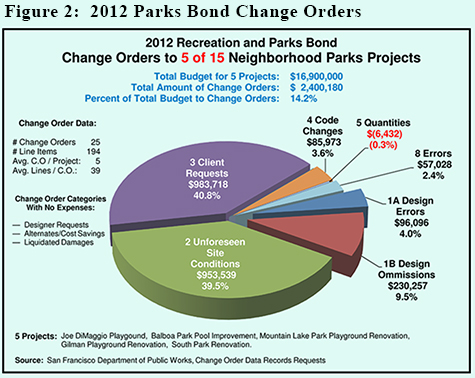 Table 5: Number of Change Orders on 2012 Parks Bond
Table 5: Number of Change Orders on 2012 Parks Bond
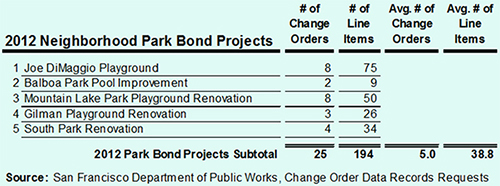
Table 6: Detailed Change Order Data for Each Project in the 2012 Parks Bond

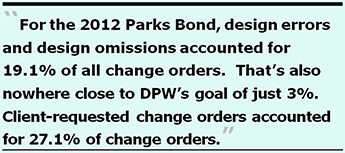 As Table 6 shows, there is again significant variability across the five parks projects in the various types of change orders, ranging from just 5.44% of change orders as a percent of a given project’s budget, to a staggering 45.8% on the South Park renovation.
As Table 6 shows, there is again significant variability across the five parks projects in the various types of change orders, ranging from just 5.44% of change orders as a percent of a given project’s budget, to a staggering 45.8% on the South Park renovation.
Again, as Table 2 above shows, for the 2012 Parks Bond, design errors and design omissions accounted for 19.1% of all change orders, while client-requested change orders soared to 27.1% of all change orders.
Overall, the five projects to date totaled $2.4 million in change orders compared to the initial $16.9 million total budget, averaging 14.2% in change orders per project, a significant jump from the 2008 bond projects.
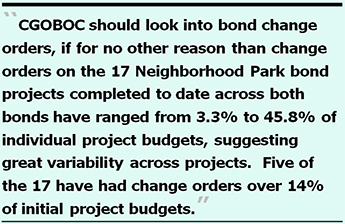 Has CGOBOC asked about any of this on both Parks bonds, or even noticed? If not, why not?
Has CGOBOC asked about any of this on both Parks bonds, or even noticed? If not, why not?
CGOBOC should look into bond change orders, if for no other reason than change orders on the 17 Neighborhood Park bond projects completed to date across both bonds have ranged from 3.3% (McCoppin Square Renovation) to 45.8 % (South Park Renovation) of individual project budgets, suggesting great variability across projects. Five of the 17 have had change orders over 14% of initial project budgets. Isn’t that excessive?
Change Orders on Other Bonds
Change orders have also been a big deal on other bond-funded projects.
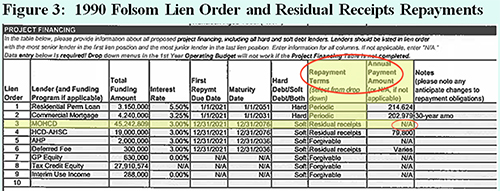 The Mayor’s Office of Housing and Community Development (MOHCD) has informed CGOBOC that one of the projects to be developed using the Affordable Housing Bond is a proposed project at 1990 Folsom, which hasn’t begun construction.
The Mayor’s Office of Housing and Community Development (MOHCD) has informed CGOBOC that one of the projects to be developed using the Affordable Housing Bond is a proposed project at 1990 Folsom, which hasn’t begun construction.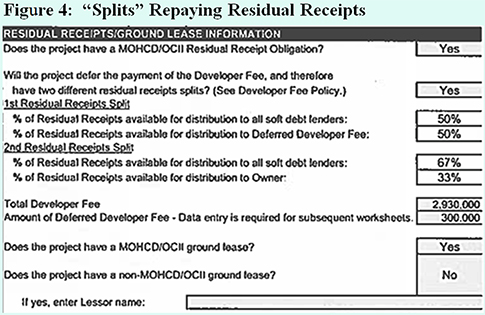 housing the chronically homeless, with supportive services on-site. The file shows that the total funding amount, and order of liens against the property, totals $102.8 million, with $45.2 million coming from MOHCD as the lender, and another $27.9 million in “tax credit equity.”
housing the chronically homeless, with supportive services on-site. The file shows that the total funding amount, and order of liens against the property, totals $102.8 million, with $45.2 million coming from MOHCD as the lender, and another $27.9 million in “tax credit equity.”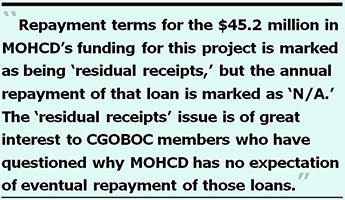 debt” lenders, and the second split providing 67% of residual receipts to “soft debt” lenders. How the “splits” are structured and works, and why deferring payment of developer fee is an issue, is not yet known.
debt” lenders, and the second split providing 67% of residual receipts to “soft debt” lenders. How the “splits” are structured and works, and why deferring payment of developer fee is an issue, is not yet known.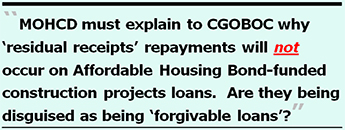 (CM/GC) projects bidding out subcontract work and purchasing materials and equipment.” “Base Scope Buyout” refers to the process in which the CM/GC (1) Bids the subcontract work and purchases materials and equipment, or (2) Negotiates the price with subcontractors, for scope that was part of the original project (“base scope”) as a way to differentiate between the pricing for scope that was added because of Errors and Omission, Client Requested Changes, Unforeseen Conditions, or Code Issues.
(CM/GC) projects bidding out subcontract work and purchasing materials and equipment.” “Base Scope Buyout” refers to the process in which the CM/GC (1) Bids the subcontract work and purchases materials and equipment, or (2) Negotiates the price with subcontractors, for scope that was part of the original project (“base scope”) as a way to differentiate between the pricing for scope that was added because of Errors and Omission, Client Requested Changes, Unforeseen Conditions, or Code Issues.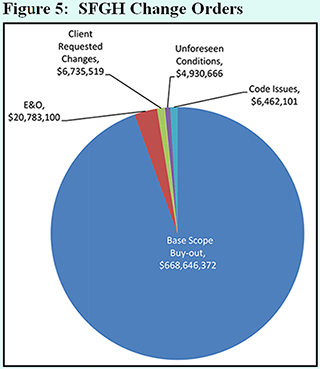 First, neither the Quantity Adjustments change order category to incorporate savings from actual quantities installed during construction, or the Alternates (a.k.a., “cost savings”) change order category were reported. Did the SFGH rebuild team make no effort to maximize bond proceeds by either trying to adjust quantities, or use “alternates” to effect any cost savings?
First, neither the Quantity Adjustments change order category to incorporate savings from actual quantities installed during construction, or the Alternates (a.k.a., “cost savings”) change order category were reported. Did the SFGH rebuild team make no effort to maximize bond proceeds by either trying to adjust quantities, or use “alternates” to effect any cost savings? Why is this category used at all to “differentiate” the various types of change orders? When “negotiating” those bids with subcontractors, does the Construction Manager also “negotiate” classifying errors made in contractor bids into the “buy-out” category to evade reporting them?
Why is this category used at all to “differentiate” the various types of change orders? When “negotiating” those bids with subcontractors, does the Construction Manager also “negotiate” classifying errors made in contractor bids into the “buy-out” category to evade reporting them?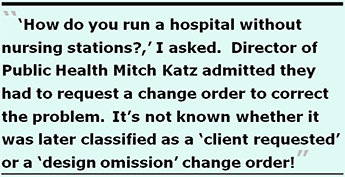 “soft costs,” fully 18% of the $887.4 million project total. It’s unknown if CGOBOC questioned whether the SFGH rebuild soft costs appeared to be excessive.
“soft costs,” fully 18% of the $887.4 million project total. It’s unknown if CGOBOC questioned whether the SFGH rebuild soft costs appeared to be excessive.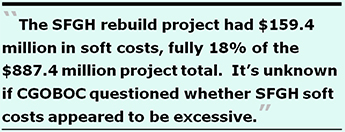 This project was not a bond-funded project, but received substantial funding from the General Fund. The project’s total budget was $1,098,720, and had two change orders (with 21 line items) totaling $73,219 (6.7%) of the total budget.
This project was not a bond-funded project, but received substantial funding from the General Fund. The project’s total budget was $1,098,720, and had two change orders (with 21 line items) totaling $73,219 (6.7%) of the total budget.Other Housing Project Change Orders
The Mayor’s Office of Housing and Community Development (MOHCD)’s annual report for FY 2015–2016 listed several projects MOHCD had undertaken with its “community partners.” Concerned about upcoming projects being funded by the $310 million Affordable Housing Bond whose construction projects will not be handled by DPW, and to get a feel for change orders performed by private construction contracts (rather than construction managed by the Department of Public Works), I chose two other MOHCD projects to obtain sample data on change orders:
 Nancy and Stephen Grand Family Home: Featured in MOHCD’s annual report is the Nancy and Stephen Grand Family Home at 540 Mission Bay Boulevard, North that opened in March 2016. Family House is a nonprofit organization providing free housing to families whose children are being treated for serious illnesses at UCSF Benioff Children’s Hospital San Francisco. The project appears to have been funded, in part, by MOHCD.
Nancy and Stephen Grand Family Home: Featured in MOHCD’s annual report is the Nancy and Stephen Grand Family Home at 540 Mission Bay Boulevard, North that opened in March 2016. Family House is a nonprofit organization providing free housing to families whose children are being treated for serious illnesses at UCSF Benioff Children’s Hospital San Francisco. The project appears to have been funded, in part, by MOHCD. “Since OCII did not providing [sic] funding this project, we do not have any responsive records to your request related to change orders. OCII approved the project’s schematic design, but did not monitor its construction.”
I followed up with OCII requesting the name of the company that had monitored construction of the project. OCII's lamely responded:“I’m not really sure. You could find out who the construction lender was and they would have monitored construction monthly at construction draw meetings/inspections.”
 Sent on a goose-chase to OCII by MOHCD, I circled back to MOHCD asking for the name of the company that monitored construction of this housing project, and the name of the construction lender. MOHCD then directed me to Related California, which is a fully-integrated real estate company that develops “top-quality, mixed-income housing and mixed-use developments across California.” When I contacted Related seeking change order data on the Nancy and Stephen Grand Family Home, they did not respond.
Sent on a goose-chase to OCII by MOHCD, I circled back to MOHCD asking for the name of the company that monitored construction of this housing project, and the name of the construction lender. MOHCD then directed me to Related California, which is a fully-integrated real estate company that develops “top-quality, mixed-income housing and mixed-use developments across California.” When I contacted Related seeking change order data on the Nancy and Stephen Grand Family Home, they did not respond.
This suggests that CGOBOC may face great difficulty obtaining change order data from private contractors on the $310 million affordable housing bond.
 CGOBOC’s Failure to Have Change Orders Audited
CGOBOC’s Failure to Have Change Orders Audited
It appears doubtful CGOBOC ever asked itself “Why are change orders for bond-funded construction projects such a large percentage of total project costs?”
When I became interested in change orders on the Laguna Honda Hospital rebuild, I noted in “LHH Lessons Unlearned Impacts All Bond-Financed Projects” (May 2010), CGOBOC heard an update from the LHH Replacement Project its April 22, 2010 meeting. As a result of written testimony I had submitted in advance of the meeting, CGOBOC member Dick Morten pointedly asked the LHH Replacement Project’s project manager, John Thomas, to comment on my assertions that the “value engineering” approach to contracting in 2004 had worked, and whether the “construction-manager-at-risk” approach that had awarded Turner Construction the general manager contract had worked.
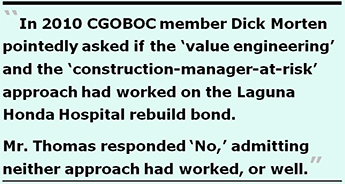 Mr. Thomas responded “No,” to both questions, admitting for the first time that neither approach had worked, or worked well. It’s long past time for the Department of Public Works and other City departments to abandon their use of “creative” contracting methods such as “design-build” and “construction-manager-at-risk” approaches that don’t work, and may have contributed (however inadvertently) to the $71.6 million in massive cost overruns on the LHH replacement project, and perhaps on other City capital construction projects.
Mr. Thomas responded “No,” to both questions, admitting for the first time that neither approach had worked, or worked well. It’s long past time for the Department of Public Works and other City departments to abandon their use of “creative” contracting methods such as “design-build” and “construction-manager-at-risk” approaches that don’t work, and may have contributed (however inadvertently) to the $71.6 million in massive cost overruns on the LHH replacement project, and perhaps on other City capital construction projects.
Across the years, I don’t recall CGOBOC ever inquiring into whether the various contracting methods have impacted expenditures on bond-funded projects or have variability in the percentages of the various types of change orders. CGOBOC has certainly not compared and contrasted, let alone investigated, whether the various contracting methods have differing results when it comes to change orders.
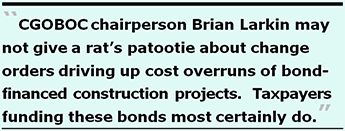 CGOBOC chairperson Brian Larkin may not give a rat’s patootie about change orders driving up cost overruns of bond-financed construction projects in the City, but the sense is, taxpayers funding these bonds most certainly do. Stay tuned to SFGOV-TV (Cable Channel 26) starting on July 17, 2017 to learn what CGOBOC does, and how ineffectual it has been since its creation in 2002!
CGOBOC chairperson Brian Larkin may not give a rat’s patootie about change orders driving up cost overruns of bond-financed construction projects in the City, but the sense is, taxpayers funding these bonds most certainly do. Stay tuned to SFGOV-TV (Cable Channel 26) starting on July 17, 2017 to learn what CGOBOC does, and how ineffectual it has been since its creation in 2002!
CGOBOC’s bylaws states in Article I, Section 4, Activities and Powers:
“Section 4 … (5) Review efforts by the City to maximize general obligation bond proceeds by implementing cost-saving measures, including, but not limited to (a) mechanisms designed to reduce the costs of professional fees and site preparation and design, and (b) recommendations regarding the joint use of core facilities and use of cost-effective and efficient reusable facility plans, and (6) commission independent review of the disbursement and expenditure of the proceeds of general obligation bonds approved by voters …”
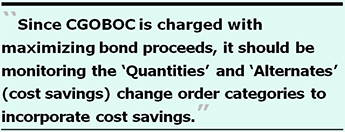 Since CGOBOC is charged with maximizing bond proceeds, it should be monitoring — if for no other reason — the “Quantity Adjustments” change order category to incorporate savings from actual quantities installed during construction, and the “Alternates” (a.k.a., “cost savings”) change order category to incorporate cost savings to maximize bond proceeds. When I stumbled across DPW’s change order database in 2010 in my research on the LHH cost overruns, the “Alternates” category was at the time titled “Cost Savings.” But the change orders on the LHH rebuild report zero in cost savings.
Since CGOBOC is charged with maximizing bond proceeds, it should be monitoring — if for no other reason — the “Quantity Adjustments” change order category to incorporate savings from actual quantities installed during construction, and the “Alternates” (a.k.a., “cost savings”) change order category to incorporate cost savings to maximize bond proceeds. When I stumbled across DPW’s change order database in 2010 in my research on the LHH cost overruns, the “Alternates” category was at the time titled “Cost Savings.” But the change orders on the LHH rebuild report zero in cost savings.
So did the SFGH rebuild project. As shown in the data above for the 2008 Neighborhood Parks bond, just $62,871 (0.5%) of the $12.3 million in change orders was attributed to “Alternates” (or cost savings).” This leaves reasonable citizen’s (“Citizen R,” as in “reasonable”) to conclude that DPW and the City appear to have no incentives to seek cost savings on bond-funded projects, and no interest in doing so.
Has CGOBOC Reconsidered Oversight Over Change Orders?
 Following its years-long foot-dragging avoiding actively monitoring and examining how change orders may intersect with CGOBCO’s duties to oversee expenditures of bond-funded program, it appears CGOBOC may finally be willing to more closely monitor change orders. It remains to be seen whether CGOBOC will aggressively monitor change orders.
Following its years-long foot-dragging avoiding actively monitoring and examining how change orders may intersect with CGOBCO’s duties to oversee expenditures of bond-funded program, it appears CGOBOC may finally be willing to more closely monitor change orders. It remains to be seen whether CGOBOC will aggressively monitor change orders.
When asked whether CGOBOC has any serious intention of ever monitoring change orders on each bond-funded project, one source noted that this reticence has been addressed and now has the full support of all  CGOBOC members. This is welcome news, but there’s lots of problematic areas remaining. And we’ll see if that really comes to pass.
CGOBOC members. This is welcome news, but there’s lots of problematic areas remaining. And we’ll see if that really comes to pass.
A Potential Standardized “Change Order” Template
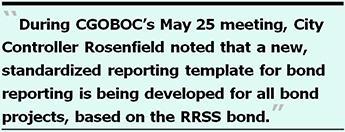 During CGOBOC’s May 25, 2017 meeting, City Controller Rosenfield noted that a new, standardized reporting template for bond quarterly reporting is being developed for all bond projects, based on the current Earthquake Safety and Emergency Response (ESER) and Road Repaving and Street Safety (RRSS) bond report formats currently in use that include reporting of change orders.
During CGOBOC’s May 25, 2017 meeting, City Controller Rosenfield noted that a new, standardized reporting template for bond quarterly reporting is being developed for all bond projects, based on the current Earthquake Safety and Emergency Response (ESER) and Road Repaving and Street Safety (RRSS) bond report formats currently in use that include reporting of change orders.
This is problematic, particularly since a recent RRSS bond presentation to CGOBOC condensed reporting of nine different types of change orders into just four categories. The alternatives, quantities, code changes, liquidated damages, and unnamed other types of change orders are lumped into just one bar on the bar chart. The design errors and design omissions change orders are also lumped into a single reporting bar.
 This is also problematic because many bonds passed by voters address multiple projects within a single bond. For instance, the 2008 Neighborhood Parks Bond had proposed 12 different neighborhoods park projects, and the 2012 Neighborhood Parks Bond had proposed 15 different neighborhood park projects. Each of those projects, as noted above, have had differing amounts of the various change orders on each project. Change orders on each of those 27 projects should be reported separately, to examine the variability and potential outliers.
This is also problematic because many bonds passed by voters address multiple projects within a single bond. For instance, the 2008 Neighborhood Parks Bond had proposed 12 different neighborhoods park projects, and the 2012 Neighborhood Parks Bond had proposed 15 different neighborhood park projects. Each of those projects, as noted above, have had differing amounts of the various change orders on each project. Change orders on each of those 27 projects should be reported separately, to examine the variability and potential outliers.
 Similarly, the RRSS bond had proposed using the bond for six types of projects, including: Street repaving and construction; streetscape, bicycle, and pedestrian safety projects; traffic signals and other street improvements for the MTA; sidewalk accessibility by improving curb ramps; sidewalk accessibility by improving sidewalks; and other street structure projects.
Similarly, the RRSS bond had proposed using the bond for six types of projects, including: Street repaving and construction; streetscape, bicycle, and pedestrian safety projects; traffic signals and other street improvements for the MTA; sidewalk accessibility by improving curb ramps; sidewalk accessibility by improving sidewalks; and other street structure projects.
Although the RRSS “template” reported the types of change orders by lumping different types of change orders together, compounding the 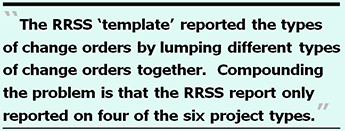 problem is that the RRSS report only reported on four of the six types of projects, and failed to report change orders for the traffic signals and other street improvements category and also failed to report change orders for the sidewalk accessibility by improving sidewalks category. One of the four types of projects reported did include the curb ramps category.
problem is that the RRSS report only reported on four of the six types of projects, and failed to report change orders for the traffic signals and other street improvements category and also failed to report change orders for the sidewalk accessibility by improving sidewalks category. One of the four types of projects reported did include the curb ramps category.
It’s not known whether those two main subcategories were eliminated due to cost overruns and change orders from the other four main subcategories, or if the “template” just isn’t flexible enough to report changes orders on each of the six project subcategories.
And the bar charts in the RRSS quarterly report for each of the four subcategories did not include data labels for each type of change order category. The total numbers reported on the bar charts simply do not add 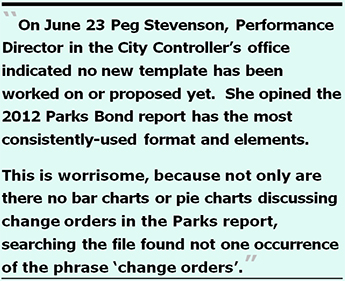 up (for instance the Streetscape bar on the bar chart reported a total of $8.0 million, but the data labels only add up to $7.7 million).
up (for instance the Streetscape bar on the bar chart reported a total of $8.0 million, but the data labels only add up to $7.7 million).
And the RRSS quarterly report does not provide the total amount of change orders across all sub-projects in a combined amount to compare to the total bond dollar amount to assess performance of change orders over the entire bond.
This would be a terrible “template” to adopt for all bond measures.
Just as writing of this article was nearing completion, on June 23 Peg Stevenson, City Performance Director in the City Controller’s office, replied to yet another records request regarding the proposed template for reporting being developed.
“Currently bond program managers are reporting to the CGOBOC in varying formats. This is why the Committee discussed the issue and is considering moving to a template. A new template has not yet been drafted. This is true for both financial and narrative information — no new template has been worked on or proposed as of yet.
I am attaching a PDF copy of a recent report to CGOBOC regarding the 2012 Parks Bond. In my observation, this report has the most common consistently used format and elements of this report would likely be used in creating a new template.”
 The recent Parks bond report Ms. Stevenson glowed about is worrisome, because not only are there no bar charts or pie charts discussing change orders, searching the file electronically found not one occurrence of the phrase “change orders.” If that’s the “best” report, CGOBOC may be in trouble without change order data being reported to it from the project sponsor!
The recent Parks bond report Ms. Stevenson glowed about is worrisome, because not only are there no bar charts or pie charts discussing change orders, searching the file electronically found not one occurrence of the phrase “change orders.” If that’s the “best” report, CGOBOC may be in trouble without change order data being reported to it from the project sponsor!
Which is it? A template “is being developed,” or “no new template has been proposed”? The Controller’s Office can’t have it both ways!
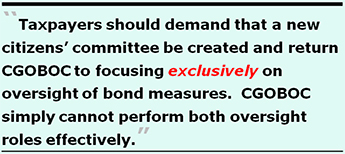 Where Do We Go From Here?
Where Do We Go From Here?
Taxpayers should demand that a new citizens’ committee be created to provide oversight and advice to the City Services Auditor function, and return CGOBOC to focusing exclusively on oversight of bond measures. CGOBOC simply cannot perform both oversight roles effectively. CGOBOC must actively start investigating change orders in detail.
As I reported in November 2016 in “Housing Delays = Justice Denied,” the San Francisco Weekly’s September 15, 2016 article,
“5 Corrupt Ways to Influence San Francisco Politics,” noted that the fifth way involves none other than change orders! Even CGOBOC members must understand this.
 When a new separate CSA oversight audit committee may hold hearings on audits of bond-funded programs, then the two separate oversight committees could hold joint-hearings. Until that happens, the overwhelmed, understaffed, and overworked CGOBOC committee will never provide true oversight on bond measures.
When a new separate CSA oversight audit committee may hold hearings on audits of bond-funded programs, then the two separate oversight committees could hold joint-hearings. Until that happens, the overwhelmed, understaffed, and overworked CGOBOC committee will never provide true oversight on bond measures.
As far as that goes, there does not seem to be a citizens’ oversight committee over investment vehicles like the so-called “multi-family revenue bond” projects, nor various capital improvement projects funded through the General Fund for projects funded by “certificates of participation,” such as the Animal Control and Care facility. Since neither investment vehicles involve any citizen oversight there is, therefore, no requirement either type of these funding alternatives are required to present publicly the amount of change orders on those capital improvement projects.
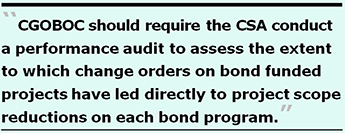 When I wrote “LHH Lessons Unlearned Impacts All Bond-Financed Projects” in May 2010, I noted that CGOBOC’s then-chairperson, Abraham Simmons (who was also a former member of the Civil Grand Jury), and other members of CGOBOC appeared to have taken seriously my suggestion that CGOBOC review the various change order categories on each bond-financed project quarterly, in order to monitor (along with encumbrances of funds) and identify early whether change orders are leading to project cost overruns. Here we are seven years later, and CGOBOC has still not examined whether cost overruns are due in large measure to change orders.
When I wrote “LHH Lessons Unlearned Impacts All Bond-Financed Projects” in May 2010, I noted that CGOBOC’s then-chairperson, Abraham Simmons (who was also a former member of the Civil Grand Jury), and other members of CGOBOC appeared to have taken seriously my suggestion that CGOBOC review the various change order categories on each bond-financed project quarterly, in order to monitor (along with encumbrances of funds) and identify early whether change orders are leading to project cost overruns. Here we are seven years later, and CGOBOC has still not examined whether cost overruns are due in large measure to change orders.
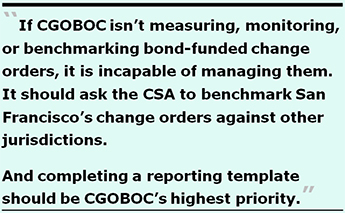 Finally, CGOBOC should require the City Services Auditor to conduct a performance audit to assess the extent to which change orders on bond funded projects have led directly to project scope reductions on each bond program.
Finally, CGOBOC should require the City Services Auditor to conduct a performance audit to assess the extent to which change orders on bond funded projects have led directly to project scope reductions on each bond program.
This calls into question whether another Grand Jury should be convened to follow up examining what the 2012–2013 Grand Jury explored about only being able to manage what you measure. Although the Grand Jury recommended benchmarking City departments against comparable cities, benchmarking appears to still not being done — five years later. It’s clear that if CGOBOC isn’t measuring, monitoring, or benchmarking bond-funded change orders, it is incapable of managing them. CGOBOC should ask the City Services Auditor to benchmark San Francisco’s change orders against other jurisdictions! And completing a reporting template should be CGOBOC’s highest priority!
Hopefully, a future Grand Jury may use reporting in this article to launch a whole new inquiry that is long overdue, and sorely needed.
Part 2 of this article examines CGOBOC’s poor performance monitoring City Services Auditor audit reports, and asks why — after CGOBOC was deemed to be the Citizen’s Audit Review Board in 2003 — it took 13 years for CGOBOC to hire an outside firm to perform bond expenditure audits.
Monette-Shaw is a columnist for San Francisco’s Westside Observer newspaper, and a member of the California First Amendment Coalition (FAC) and the ACLU. Contact him at monette-shaw@westsideobserver.com.
Top
Footnotes:
1 The five 2012 Park Bond projects for which change order data is available includes: 1) Joe DiMaggio Playground; 2) Balboa Park Pool Improvement, a project not yet complete; 3) Mountain Lake Park Playground Renovation; 4) Gilman Playground Renovation; and the South Park Renovation.
The ten 2012 Park Bond projects for which no change order data is yet available and may not have yet been reported to CGOBOC include projects for the: 1) Angelo J. Rossi Pool, 2) Garfield Square Pool Improvement Project, 3) George Christopher Playground, 4) Glen Canyon Recreation Center, 5) Hyde – Turk Mini Park, 6) Margaret S. Hayward Playground, 7) Moscone Recreation Center – East Playground, 8) Potrero Hill Recreation Center, 9) West Sunset Playground, and 10) Willie “Woo Woo” Wong Playground. A reminder: We’re now five years into passage of the 2012 Parks bond with no data available for two-thirds of the bond-funded projects!
2 This article focuses only change orders for neighborhood parks projects in both the 2008 and 2012 Parks bonds. The 2008 bond was for $185 million, with $117 million (63.2%) allocated for neighborhood parks, and the remaining $68 million for other citywide projects. The 2012 bond was for $195 million, with $99 million (50.8%) allocated for neighborhood parks, and the remaining $96 million for other citywide projects. Again, the quarterly reports the Recreation and Parks Department submits to CGOBOC do not currently present change order information, and only report high-level financial data for each neighborhood parks projects and for the citywide projects. Clearly, CGOBOC should be evaluating change orders for all projects in each of the two bonds.
3 This The Department of Public Works (DPW) provided 60 change order files on the SFGH rebuild bond measure in PDF format on a CD following a public records request. They totaled approximately 600 pages of data that was not in the same Microsoft Excel format that DPW provided for the neighborhood parks bonds change order data. Those 60 PDF files were not closely examined for this article.